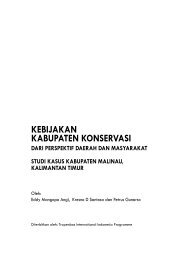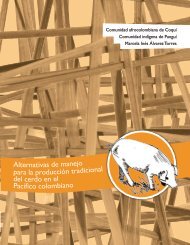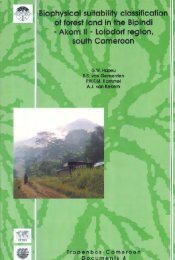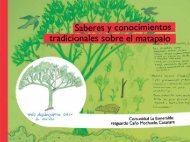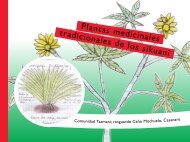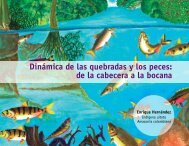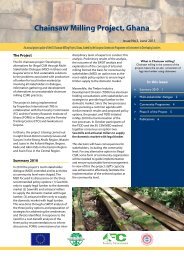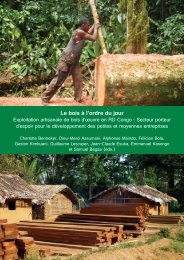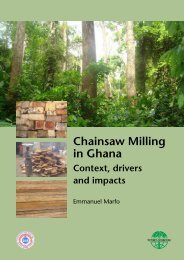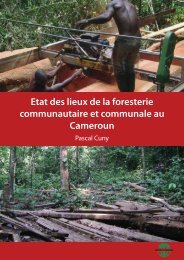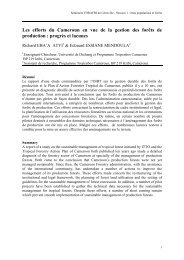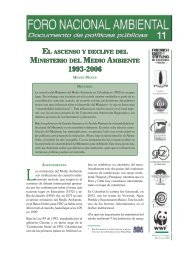Download the publication - Tropenbos International
Download the publication - Tropenbos International
Download the publication - Tropenbos International
You also want an ePaper? Increase the reach of your titles
YUMPU automatically turns print PDFs into web optimized ePapers that Google loves.
6.1. INTRODUCTION<br />
General conclusions and implications for biodiversity conservation<br />
The Campo-Ma’an rain forest is recognised to be an important site within <strong>the</strong><br />
Guineo-Congolian Regional Centre of Endemism (White, 1979 & 1983). Its<br />
conservation value is high at local, national, regional and global levels (Gartlan,<br />
1989 & 1992; Foahom & Jonkers, 1992; Thomas & Thomas, 1993; Davis et al.,<br />
1994; de Kam et al., 2002). However, despite its great biological importance, <strong>the</strong><br />
Campo-Ma’an forest has suffered and continues to suffer from intense human<br />
pressure that has led to <strong>the</strong> degradation of most of <strong>the</strong> forest along <strong>the</strong> coast and <strong>the</strong><br />
lowland forest around settlements. It is largely in order to ensure <strong>the</strong> conservation of<br />
biodiversity and <strong>the</strong> sustainable management of its natural resources that a Technical<br />
Operational Unit (TOU) was created in <strong>the</strong> Campo-Ma’an area. The main<br />
components of <strong>the</strong> TOU are a National Park, five forestry management units, two<br />
agro-industrial plantations and several agro-forestry zones (Chapter 1). So far, <strong>the</strong><br />
National Park exists only on paper since in reality it has not yet been gazetted, and it<br />
has no boundary and management plan. Taking into consideration <strong>the</strong> fact that <strong>the</strong>re<br />
was limited baseline biological information, essential for <strong>the</strong> elaboration of <strong>the</strong><br />
Campo-Ma’an strategic and management plans, it was of vital importance to carry<br />
out sound taxonomic and ecological research in order to identify conservation<br />
priorities and hotspots for biodiversity conservation.<br />
During this study, a vegetation map of <strong>the</strong> Campo-Ma’an area was produced and <strong>the</strong><br />
various vegetation types were described with information on <strong>the</strong>ir structure and<br />
composition (Chapter 2). A plant species checklist (Annex 3) made of 2297 species<br />
of vascular plants, ferns and fern allies was generated from inventory data and from<br />
2348 herbarium specimens and 4789 ecological specimens. They belonged to 851<br />
genera and 155 families. Fur<strong>the</strong>rmore, a list of 92 threatened species recorded in<br />
IUCN (2002) and WCMC (1998), and a list of 141 plant species of high<br />
conservation priorities were produced, with information on <strong>the</strong>ir growth forms,<br />
guild, chorology and conservation status (Chapter 5). The distribution maps of<br />
species of high conservation priority such as endemic, rare, threatened, and bioindicator<br />
taxa, were produced and used to identify and locate potential hotspots for<br />
biodiversity conservation, and to confirm <strong>the</strong> existence of a postulated Pleistocene<br />
rain forest refuge in <strong>the</strong> Campo-Ma’an area (Chapters 4 & 5).<br />
6.2. GENERAL CONCLUSION<br />
The most important phytogeographic studies of Africa are those of White (1979 &<br />
1983) who divided Africa into floristic units (phytochoria) based on chorological<br />
criteria such as shape, surface and geographic position of species distributions and<br />
on <strong>the</strong> occurrence of endemics. This led him to distinguished Regional Centres of<br />
Endemism defined as phytochoria that show a total of more than 1000 endemic<br />
species and to which more than half of <strong>the</strong> total number of its species is confined.<br />
The sou<strong>the</strong>rn part of Cameroon falls under <strong>the</strong> Guineo-Congolian Regional Centre<br />
of Endemism that is reported to be species-rich with high levels of endemism<br />
(White, 1983; Davis et al., 1994). The Guineo-Congolian region comprises three<br />
sub-divisions, Upper Guinea, Lower Guinea and Congolia. The Lower Guinea subregion<br />
comprises <strong>the</strong> Atlantic Biafran forest zone that extends from Sou<strong>the</strong>ast<br />
Nigeria to Gabon and <strong>the</strong> Mayombe area in Congo (Letouzey, 1985). The Campo-<br />
115



